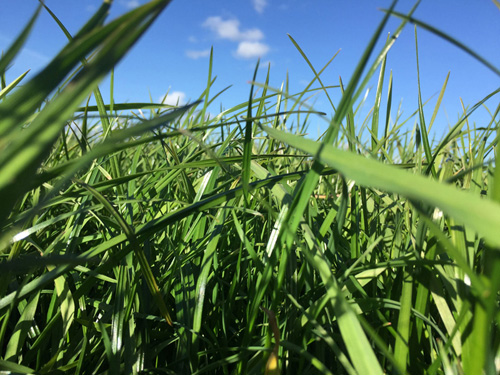With temperatures across the UK forecast to remain slightly higher than average for the remainder of September and into early October, many farmers are taking advantage of warmer soil conditions and seizing the opportunity to reseed or overseed older leys. In the last month, the agricultural team at Barenbrug – one of the UK’s leading producers of forage grass – has seen a significant uplift in sales with much of the country sowing 30% more seed than normal. As well as short term leys, which are being heavily used to help fill the forage gap, Barenbrug has seen a massive upsurge in upland / hill ground reseeding. In Scotland, upland mixture sales are more than 50% up on last year. While in England and Wales, sales are around 40% higher than normal.
The news comes as Barenbrug launches the second edition of its Good Grass Guide – a free-of-charge booklet packed with practical pointers about gauging grass quality and repairing and renovating fields.
Mhairi Dawson, research and development manager at Barenbrug UK said: “It’s been a really difficult grass-growing year for many UK farmers – with the weather literally throwing everything at us. After a very long, hard winter, many farmers needed several good cuts this summer to replenish dwindling forage reserves. Unfortunately, because of the hot dry weather, that didn’t happen. With the weather now back to normal, but slightly warmer than average, many farmers are opting to invest in new grass. Favourable conditions are enabling farmers to make ground improvements plus an early maize harvest has opened up opportunities for extra autumn reseeds. The grass varieties currently proving most popular are specialist mixtures that germinate well into October and give farmers total flexibility with 12, 18 or 24-month production potential – including extra grazing opportunities over winter.”
While Barenbrug’s figures don’t show if farmers are planning to reseed or overseed with the mixtures they are buying, there are compelling arguments for both options – as set out in the company’s Good Grass Guide, which has been described as an essential tool by many seed merchants.
Explaining more Mhairi said: “Some livestock producers may still be reticent about reseeding given the impact this summer’s weather has had on farm finances. But you can actually make a real impact on grass quality, productivity and utilization by doing very little. A reseeding rate of just 10% is enough to prevent a decline in grass productivity while 15% will start to deliver real gains. Farmers also shouldn’t rule out overseeding, which can make a big difference after the kind of summer we’ve just had. Implemented carefully, overseeding can improve pasture productivity by between 30-40% for between three to four years, depending on field quality. When it comes to investing in grass, our message is simple. Doing something is always better than doing nothing and new swards will always be more productive than old ones and better equipped to deal with weather extremes.”
To help farmers get their grassland management back on track this autumn, after one of the hottest, driest, summers on record, Barenbrug has updated its Good Grass Guide – adding more information and hints and tips to the booklet, which farmers can obtain from the Barenbrug website. The second edition of the Good Grass Guide includes information about reseeding versus overseeding; seed selection and managing new swards. There are pages dedicated to soil nutrition and structure; and why investing in grass is important. There are also photographs and facts and figures about productive grass species, common weeds, diseases and pests. At the back of the guide there is also space for farmers to note down observations about individual fields and pastures.




